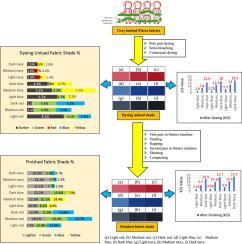优化纺织染整,提高羊毛针织物的能效和可持续性
引用次数: 0
摘要
在工业范围内,优化染整能源对控制环境污染非常重要。在染色阶段到纺织品整理阶段,燃气、电、蒸汽和水的使用量分别为 260 立方米/小时、591 千瓦时、1.2 磅/小时和 8.69 吨/小时。如果纺织专业人员不能在使用最少资源的情况下获得理想的织物色调和质量,能源成本将成倍增加。本研究调查了羊毛针织物从染色卸载到后整理阶段的色调变化,并假设了染色配方调整,重点关注优化染色和后整理工艺的影响。此外,它还关注各种颜色变化的特性质变。红色、蓝色和藏青色的浅色、中色和深色的染色配方完全相同。对 GSM(每平方米克重)、幅宽、色强、色调(深/浅、红/绿、蓝/黄)、收缩率、螺旋度、起球、爆破强力和色牢度等特性进行了分析。从染色到后整理,色牢度(K/S)值都有所提高,例如浅红色的色牢度从 2.9 提高到 3.18,深海军蓝的色牢度从 19.3 提高到 22.9。在拉幅机第一道拉幅后,可以观察到较深的色调(DL*)(在所有变体中,红色:1.2 % 至 8.1 %,深蓝色:1.2 % 至 8.1 %):红色:1.2 % 至 8.1 %,蓝色:4.5 % 至 6.7 %:在所有变种中,红色:1.2 % 至 8.1 %,蓝色:4.5 % 至 6.7 %,藏青色:1.6 % 至 2 %),而在播种和打盹后观察到较浅的色调(DL*):在所有变体中,红色:3.1 % 至 19.7 %,蓝色:11.8 % 至 19.7 %:在所有变体中,红色:3.1 % 至 19.7 %,蓝色:11.8 % 至 19.7 %,深蓝色:14.8 % 至 27.6 %)。在后整理阶段,偏绿(Da*)和偏黄(Db*)的色调在所有颜色中都很突出。此外,其他性能收缩率、螺旋度、起毛起球、爆破强力和色牢度也发生了显著变化。这些发现为染色专业人员提供了宝贵的指导,使他们能够实现符合质量标准的理想色调调整,并生产出可持续发展的羊毛织物。为了补偿整理过程中出现的色调变浅,建议在染色阶段保持织物色调稍深(5.70 % 至 23.10 %)。本文章由计算机程序翻译,如有差异,请以英文原文为准。

Optimizing textile dyeing and finishing for improved energy efficiency and sustainability in fleece knitted fabrics
In the industrial range, optimizing dyeing and finishing energy is important to control environmental pollution. In the Dyeing stage to finishing of textiles gas, electricity, steam, and water are used 260 m3/hour, 591 kWh, 1.2 pounds/hour, and 8.69 tons/hour respectively. If textile professionals do not match the desired shade and quality of fabrics with the use of minimal resources the energy cost will be multiple times higher. This study investigates the change in the shade of fleece knitted fabrics from the dyeing unload to the finish stage and assumes a dyeing recipe adjustment, focusing on the impact of optimized dyeing and finishing processes. Also, it focuses on qualitative changes in properties across various color variations. Identical dyeing recipes for light, medium, and dark shades of red, blue, and navy. Properties such as GSM (grams per square meter), width, color strength, shade (darker/lighter, red/green, blue/yellow), shrinkage, spirality, pilling, bursting strength, and color fastness were analyzed. Dyeing to post-finishing, an increase in color strength (K/S) values was observed, with examples including minimum increases from 2.9 to 3.18 for light red and maximum from 19.3 to 22.9 for dark navy shade. Darker shades (DL*) were observed after stenter 1st pass (among all variants, red: 1.2 % to 8.1 %, blue: 4.5 % to 6.7 %, navy: 1.6 % to 2 %), while lighter shades (DL*) were observed following sueding and napping (among all variants, red: 3.1 % to 19.7 %, blue: 11.8 % to 19.7 %, navy: 14.8 % to 27.6 %). Greenish (Da*) and yellowish (Db*) tones are prominent across all colors in the finishing stages. Besides, other properties shrinkage, spirality, pilling, bursting strength, and color fastness significantly changed. These findings offer valuable guidance for dyeing professionals aiming to achieve the desired adjustment of shades that match the quality standard and produce sustainable fleece fabrics. To compensate for the shade lightening that occurs during the finishing process, it is recommended to keep the fabric shade slightly darker (5.70 % to 23.10 %) at the dyeing stage.
求助全文
通过发布文献求助,成功后即可免费获取论文全文。
去求助

 求助内容:
求助内容: 应助结果提醒方式:
应助结果提醒方式:


